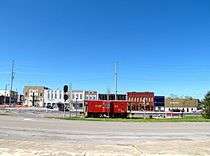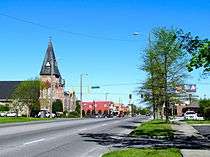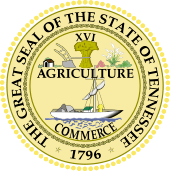Tullahoma, Tennessee
| Tullahoma, Tennessee | |
|---|---|
| City | |
 | |
| Nickname(s): Queen City | |
| Motto(s): Tennessee's Rising Star | |
 Location of Tullahoma in Coffee and Franklin Counties, Tennessee. | |
| Coordinates: 35°22′7″N 86°12′48″W / 35.36861°N 86.21333°WCoordinates: 35°22′7″N 86°12′48″W / 35.36861°N 86.21333°W | |
| Country | United States |
| State | Tennessee |
| Counties | Coffee, Franklin |
| Incorporated | October 4, 1852 |
| Government | |
| • Mayor | Blaise Poarch |
| Area | |
| • Total | 23.6 sq mi (61.0 km2) |
| • Land | 23.5 sq mi (60.8 km2) |
| • Water | 0.08 sq mi (0.2 km2) |
| Elevation | 1,070 ft (326 m) |
| Population (2010)[1] | |
| • Total | 18,655 |
| • Estimate (2016)[2] | 19,273 |
| • Density | 794/sq mi (306.6/km2) |
| Time zone | UTC−6 (Central (CST)) |
| • Summer (DST) | UTC−5 (CDT) |
| ZIP Codes | 37388–37389 |
| Area code(s) | 931 |
| FIPS code | 47-75320[3] |
| GNIS feature ID | 1272964[4] |
| Website |
www |
Tullahoma is a city in Coffee and Franklin counties in southern Middle Tennessee. The population was 18,655 at the 2010 census.[1] In 2014 the population was estimated to be 18,899.[5] It is the principal city of the Tullahoma micropolitan area, which consists of Coffee, Franklin, and Moore counties and is the second largest micropolitan area in Tennessee.
History
Tullahoma was founded in 1852 as a work camp along the new Nashville and Chattanooga Railroad. Its name is derived from the Choctaw language, and means "red rock".
An alternative explanation (see Sam Davis Elliott's Soldier of Tennessee and sources cited therein) of the name is that Peter Decherd, who donated the land for the railroad right-of-way (and was therefore given the right to name two stations along the line), named one station Decherd, after himself, and the other as Tulkahoma (later changed to Tullahoma). Tulkahoma was the name of Decherd's favorite horse, which had had named for a Choctaw chief who had been captured by Decherd's grandfather. (There was also a town of Tullahoma, Mississippi; that settlement later changed its name to Grenada.)
The earliest settlement was by farmers, mostly from Virginia and North Carolina. With the use of enslaved African Americans, they developed plantations for tobacco and hemp. Slaves also cared for their blooded livestock, both horses and cattle. Early settlers were Moore, Decherd/anglicized as Deckerd, Anderson, Ragon, Montgomery, Ferrell, Stephenson, and Gunn.
They named a local spring as Bottle Spring, and later referred to it as John Gunn's Spring, because it was on his property. In the 21st century, it is called Big Springs. This spring provided water for the steam locomotives. Later it was exploited for health and tourist attractions, as the town developed spa facilities.[6]
After the Civil War started, in April 1861, Company B, 1st Regiment of Tennessee Volunteers, formed Peter Turney's division in Tullahoma. The division joined General Robert E. Lee's Army of Northern Virginia. The division fought in the battles of Bull Run, Fredericksburg, Chancellorsville, Gettysburg, and Petersburg, before surrendering to Union General Ulysses S. Grant at Appomattox.
During the war, Tullahoma served in 1863 as the headquarters for the Confederate Army of Tennessee. That year the Union Army undertook the Tullahoma Campaign, defeating Confederate forces and taking control of Middle Tennessee. Federal troops occupied this area for the duration of the war. Union forces also captured Chattanooga.

Tullahoma was little more than a rough frontier outpost, and had no paved streets. 1863 was a wet year, and the place became known to the bedraggled troops of both sides as a place of endless mud. An aide on Confederate General William Hardee's staff is said to have written his own account of the origin of the name: "It is from two Greek words - 'Tulla' meaning mud, and 'Homa,' meaning more mud."
The selection of Tullahoma as a headquarters by Confederate General Braxton Bragg has been much criticized by military historians. Although the location was strategic with regard to the road and rail network, it had no strong natural defenses. Bragg did little to fortify it while his forces occupied the area. Eventually the town was evacuated without a battle.
After the war, Tullahoma recovered slowly, but began to prosper owing to its railroad link. It became renowned for its educational facilities, a rarity in the area at the time.
At the turn of the 20th century, Tullahoma became a popular health destination, with many spas across town to take advantage of Big Springs.
Manufacturing was developed in the area, notably of shoes, clothing, and sporting goods. In 1924, the General Shoe Corporation was established here, which eventually developed as Genesco. The diversified apparel firm is Tennessee's oldest listed firm on the New York Stock Exchange. Since the early 1900s, a variety of sports products have been manufactured in Tullahoma, including baseballs, bats, and golf clubs by Campbell Mfg, Wilsons, Worth Sports, and Rawlings.
In 1939, U.S. Route 41A was built through town. This improved access between the town and Nashville, 71 miles (114 km) to the northwest, and Chattanooga, 77 miles (124 km) to the southeast.
The noted whiskey brand of George Dickel has its roots in Tullahoma. Jack Daniel's whiskey is distilled 12 miles (19 km) southwest of Tullahoma in Lynchburg.
From the 1930s to mid-20th century, the area benefited from considerable federal investment and development: the projects of the Tennessee Valley Authority constructed dams and related facilities to generate hydroelectric power and electrify many rural areas, as well as providing needed jobs during the Great Depression. Camp Forrest was established during World War II as an infantry training center and later POW camp. The Arnold Engineering Development Complex (AEDC) was the site of early wind tunnel testing by the Air Force and NASA. Later the state established two institutions of higher learning here, Motlow State Community College, and the University of Tennessee Space Institute.
Today manufacturing makes up a smaller part of the Tullahoma economy. The town's growth has been steady though slow since the late 20th century, based on a mixture of education, services, tourism, and retail. The presence of AEDC and the Space Institute, combined with a convenient proximity to the aerospace center of Huntsville, Alabama, has bred a small but thriving aeronautical industry as well. A national aircraft preservation museum, Beechcraft Heritage Museum, was established on grounds south of the city's municipal airport.[7]
Tullahoma celebrated its 150th (sesquicentennial) anniversary on October 4, 2002.
Fiber-to-the-Home
The Tullahoma Utilities Board (TUB) built a fiber-to-the-premise structure in 2006 and began billing customers in 2009 under its LightTUBe division, which offers television feed, telephone service, and high-speed broadband internet access. In the fall of 2006, the city did a feasibility study, and in December of that year, the TUB board of directors voted to move forward with the project. TUB held open houses and a public hearing to inform residents about its plans.
The TUB board had endorsed the fiber project on a 5-0 vote, but the City Council's approval was needed to secure funding for the project. In April 2007, the council gave the project a green light, and fiber was being installed by December 2007. TUB installed approximately 200 miles of fiber optics. By the summer of 2008, the utility was conducting beta testing with customers, and in January 2009, TUB began billing its first customers.
Today, the utility has approximately 3,500 customers for its LightTUBe system. Soon after it started the TV service, management provided a TV station to produce community events and sports, a thrice-weekly news broadcast, and a weekly talk show.
TUB's LightTUBe division began offering gigabit broadband service in 2009. Tullahoma is one of the smallest cities to have a gigabit fiber optic system, and it is one of only a handful of cities in the country to offer high-speed internet.
Geography
Tullahoma is located in the southwest corner of Coffee County at 35°22′7″N 86°12′48″W / 35.36861°N 86.21333°W (35.368511, -86.213258),[8] and extends south into Franklin County. It is situated at the edge of the Highland Rim, with flatter topography than in the surrounding area. The region was known as "the Barrens" to the first settlers.
According to the United States Census Bureau, the city has a total area of 23.6 square miles (61.0 km2), of which 23.5 square miles (60.8 km2) is land and 0.1 square miles (0.2 km2), or 0.30%, is water.[1]
Climate
Climate is characterized by relatively high temperatures and evenly distributed precipitation throughout the year. The Köppen Climate Classification subtype for this climate is "Cfa" (Humid Subtropical Climate).[9]
| Climate data for Tullahoma, Tennessee | |||||||||||||
|---|---|---|---|---|---|---|---|---|---|---|---|---|---|
| Month | Jan | Feb | Mar | Apr | May | Jun | Jul | Aug | Sep | Oct | Nov | Dec | Year |
| Average high °C (°F) | 10 (50) |
12 (53) |
17 (62) |
22 (71) |
26 (79) |
30 (86) |
32 (89) |
31 (88) |
29 (84) |
23 (73) |
16 (60) |
11 (51) |
22 (71) |
| Average low °C (°F) | −1 (31) |
0 (32) |
4 (39) |
8 (47) |
12 (54) |
17 (63) |
19 (66) |
18 (65) |
15 (59) |
8 (47) |
3 (37) |
0 (32) |
9 (48) |
| Average precipitation mm (inches) | 142 (5.6) |
132 (5.2) |
150 (6) |
122 (4.8) |
100 (4) |
104 (4.1) |
130 (5) |
97 (3.8) |
84 (3.3) |
74 (2.9) |
99 (3.9) |
142 (5.6) |
1,370 (54) |
| Source: Weatherbase [10] | |||||||||||||
Demographics
| Historical population | |||
|---|---|---|---|
| Census | Pop. | %± | |
| 1860 | 586 | — | |
| 1870 | 589 | 0.5% | |
| 1880 | 1,083 | 83.9% | |
| 1890 | 2,439 | 125.2% | |
| 1900 | 2,684 | 10.0% | |
| 1910 | 3,049 | 13.6% | |
| 1920 | 3,479 | 14.1% | |
| 1930 | 4,023 | 15.6% | |
| 1940 | 4,549 | 13.1% | |
| 1950 | 7,562 | 66.2% | |
| 1960 | 12,242 | 61.9% | |
| 1970 | 15,311 | 25.1% | |
| 1980 | 15,800 | 3.2% | |
| 1990 | 16,761 | 6.1% | |
| 2000 | 17,994 | 7.4% | |
| 2010 | 18,655 | 3.7% | |
| Est. 2016 | 19,273 | [2] | 3.3% |
| Sources:[5][11] | |||
As of the 2010 census,[3] there were 18,655 people, 7,717 households, and 5,161 families residing in the city. The racial makeup of the city was 88.1% White, 7.0% African American, 0.2% Native American, 1.2% Asian, 1.1% from other races, and 2.5% from two or more races. Hispanic or Latino of any race were 3.1% of the population.

As of the 2000 census,[3] there were 17,994 people, 7,336 households, and 5,039 families residing in the city. The population density was 809.6 people per square mile (312.5/km²). There were 7,890 housing units at an average density of 355.0 per square mile (137.0/km²). The racial makeup of the city was 89.69% White, 6.76% African American, 0.28% Native American, 1.01% Asian, 0.05% Pacific Islander, 0.64% from other races, and 1.57% from two or more races. Hispanic or Latino of any race were 1.71% of the population.
There were 7,336 households out of which 32.3% had children under the age of 18 living with them, 51.9% were married couples living together, 13.3% had a female householder with no husband present, and 31.3% were non-families. Of all households 27.3% were made up of individuals and 11.8% had someone living alone who was 65 years of age or older. The average household size was 2.42 and the average family size was 2.94.
In the city, the population was spread out with 25.4% under the age of 18, 8.6% from 18 to 24, 26.9% from 25 to 44, 23.0% from 45 to 64, and 16.1% who were 65 years of age or older. The median age was 38 years. For every 100 females, there were 90.5 males. For every 100 females age 18 and over, there were 85.6 males.
The median income for a household in the city was $34,119, and the median income for a family was $39,797. Males had a median income of $33,662 versus $20,962 for females. The per capita income for the city was $20,002. About 14.2% of families and 17.2% of the population were below the poverty line, including 25.0% of those under age 18 and 13.0% of those age 65 or over.
Performing arts
Tullahoma is renowned for its diverse performing arts groups. Tullahoma High School supports instrumental, vocal, theatrical, and visual arts. The THS Band program is recognized for it excellence across the state and country. Their bands have received numerous honors under the direction of Stephen and Marion Coleman and currently, Justin Scott and Lisa Burden. The choral department was developed under Ann S. Baldwin, who started its show choir in 1976, one of the first in the area. Reviving in the past two years is the theatre program, under the direction of Aaron Miller. The past two years include productions such as The Princess Bride, Beauty and the Beast, and The Phantom of the Opera.
There are many additional venues for the performing arts. The Annual 41A Music Festival hosts local music talent and national artists. The Fine Arts Center displays new artwork monthly from local visual artists. South Jackson Civic Center hosts the South Jackson Civic Association, P.A.C.T. (Performing Arts for Children and Teens), and Community Playhouse, Inc. All three organizations produce multiple shows annually, ranging from classic plays such as A Christmas Carol to Broadway musicals such as Guys and Dolls and Oliver!, and an annual show production under the direction of Peggy Burton, South Jackson Goes Country.
Education
Tullahoma hosts two state institutions of higher learning, Motlow State Community College and the University of Tennessee Space Institute.
K–12 public education is provided through a city school system.
Tullahoma High School "Wildcat" athletic teams compete in the TSSAA in public school divisions. The Tullahoma Wildcat Football Team is currently in the 5A classification while all other team sports compete in 3A.
Transportation
The Tullahoma Regional Airport was originally constructed in 1942 for the U. S. Army Air Corps. It features wide heavy duty runways, a large ramp, taxiways and large hangars. Over 100 aircraft are presently based at the airport, with additional capacity available. Over 2,000 transient aircraft visit the airport annually.[12]
In popular culture
"Tullahoma Dancing Pizza Man" is a song by country artist Eddie Rabbitt on his second studio album, Rocky Mountain Music, released in 1976.
Notable people
- Dewon Brazelton, born here; baseball player[13]
- Eric Clutton,[14] resides here; popularly known as Doctor Diesel, he is a renowned designer of aeromodels and the FRED experimental aircraft.
- Isham G. Harris, born near Tullahoma; politician and former Tennessee governor .
- Antonio London, born here; football player[15]
- Dustin Lynch, born here; country singer.
- Steve Matthews, born in Tullahoma; football player[16]
- Bryan Morris, from here; professional baseball player
- Jordan Sheffield, born and raised here; professional baseball player
- Justus Sheffield, born and raised here; professional baseball player
- Jimmy Valiant, born near Tullahoma. This professional wrestler is known as "The Boogie Woogie Man" and "Handsome" Jimmy Valiant.
- Ally Walker, born here; actress.
- David Hess, born here; professional baseball player
References
- 1 2 3 "Geographic Identifiers: 2010 Census Summary File 1 (G001): Tullahoma city, Tennessee". U.S. Census Bureau, American Factfinder. Retrieved July 7, 2015.
- 1 2 "Population and Housing Unit Estimates". Retrieved June 9, 2017.
- 1 2 3 "American FactFinder". United States Census Bureau. Retrieved 31 January 2008.
- ↑ "US Board on Geographic Names". United States Geological Survey. 25 October 2007. Retrieved 31 January 2008.
- 1 2 "Annual Estimates of the Resident Population: April 1, 2010 to July 1, 2014 (PEPANNRES): Incorporated Places in Tennessee". U.S. Census Bureau, American Factfinder. Retrieved July 7, 2015.
- ↑ Historical & Biographical Sketches of Coffee County, TN
- ↑ Museum website
- ↑ "US Gazetteer files: 2010, 2000, and 1990". United States Census Bureau. 12 February 2011. Retrieved 23 April 2011.
- ↑ Climate Summary for Tullahoma, TN
- ↑ "Weatherbase.com". Weatherbase. 2013. Retrieved on July 13, 2013
- ↑ "Census of Population and Housing: Decennial Censuses". United States Census Bureau. Retrieved 4 March 2012.
- ↑ FAA Airport Master Record for THA (Form 5010 PDF). Federal Aviation Administration. Effective May 31, 2012.
- ↑ "Dewon Brazelton Stats". Baseball Almanac. Retrieved November 10, 2012.
- ↑ "Eric Clutton". Clutton Fred. Retrieved April 26, 2016.
- ↑ "Antonio Monte London". databaseFootball.com. Archived from the original on October 7, 2012. Retrieved November 10, 2012.
- ↑ "Stephen Keith Matthews". databaseFootball.com. Archived from the original on May 30, 2012. Retrieved November 10, 2012.
External links
| Wikimedia Commons has media related to Tullahoma, Tennessee. |
- City of Tullahoma official website
- Tullahoma city schools
- Think Tullahoma, City of Tullahoma Economic Development Corporation
- City charter
- The Tullahoma Campaign in the Tennessee Encyclopedia of History and Culture
